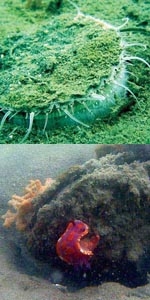PDF of this article (410 KB)

Kay Vopel and Greig Funnell look into the mechanisms and creatures that help maintain the seabed’s life-support system.
Aquatic sediment provides an important ecosystem service: the decomposition of organic matter and the associated regeneration of nutrients for algae and plants. In coastal marine ecosystems, more than half of the nutrients available for primary production in the water column and at the sediment surface can be supplied by the sedimentary processes of aerobic and anerobic decomposition. The most important (and abundant) players in this service are aerobic and anaerobic bacteria, which transform organic into inorganic matter using oxidants such as oxygen and nitrate.


To supply the bacteria with oxidants, the sediment breathes, just like we do to supply our cells. When we breathe, we transport oxygen into our lungs and from there into the bloodstream by air flow and molecular diffusion. We draw our diaphragm down to inhale air and up to exhale. This maintains an oxygen concentration in the alveoli of our lungs that is sufficiently high to let oxygen molecules diffuse from the alveoli into our blood. A similar principle applies to aquatic sediment.
Diffusion and the effects of water flow
Flow of oxygenated seawater and oxygen consumption in the sediment cause a concentration difference across the sediment–water interface. This difference drives the diffusion of oxygen molecules from the bottom water into the spaces between sediment particles (the pore space). Once oxygen passes the so-called ‘diffusive boundary layer’ between the free-flowing bottom water and the sediment, it diffuses within the pore space of the sediment and across the surface of millions of bacteria that are either floating in the pore water or attached to sediment particles.
However, studies show that sediment takes up much more oxygen than we would expect just from diffusion across the surface of the sediment. This is due to various mechanisms that work like the movements of our diaphragm: pressure changes cause flow that supplies oxygen to the huge surface area of all the particles and attached bacteria that make the upper sediment.
One mechanism is related to the effects of wind waves: in shallow water, pressure fluctuations due to wind waves move the pore water of the upper sediment and thus keep the pore space of the upper sediment oxygenated. A second mechanism is due to water flow over obstructions such as sessile (attached) animals on the surface of the sediment, traces and mounds of other animals, and sediment ripples. This water flow also generates pressure differences that cause flow through the pore space of the sediment. A third ‘breathing mechanism’ results from the pumping activity of burrowing macrobenthic species such as worms, crabs, and echinoderms. Although all these mechanisms supply oxygen to the system, it is the role of the hidden animal pumps that NIWA scientists are currently investigating.
Hidden animal pumps
To gain food and oxygen many marine animals pump seawater. Their fluid-forcing devices are diverse in both form and function, but there are two principle types of pumps. ‘Positive displacement pumps’ produce a high pressure difference from input to output but deal with a relatively low throughput of seawater. ‘Fluid dynamic pumps’ might exert the same power, but invest it in a high volume flow at only a small increment in pressure.
Nature’s main use of fluid-dynamic pumps is in suspension feeding. Suspended food is present in most natural waters, but it does not normally exist in high concentrations. To get sufficient food, the animal must process a lot of water. Common suspension feeders include sponges, clams, scallops, and mussels. Most of these live above or on top of the sediment and only affect the gas exchange of the sediment indirectly as obstructions to the bottom-water flow.
In contrast, animals that live within the sediment often employ positive displacement pumps. They ventilate the sediment, both increasing sediment oxidants and releasing nutrients from the sediment. For example, lugworms and some brittle stars move water through their burrows by passing peristaltic waves down their bodies. The clam worm, Nereis diversicolor, pushes water through its burrow by swinging a series of paddle-like appendages, driving the fluid in much the same manner as a propeller.
The classification of pumps into volume and pressure pumps does not completely reflect nature’s technology because animal pumps differ in their mechanics. For example, the positive-displacement pump of the burrow-making marine worm Chaetopterus produces only a relatively low pressure, and the fluid-dynamic pump of the burying heart urchin, Echinocardium australe, is capable of producing relatively high pressure. (Read more about the heart urchin in “Burrowing heart urchins”.)
Our recent experiments indicate that, although it uses a fluid-dynamic pump, the heart urchin can have profound effects on the gas exchange of coastal sediment. It does so by maintaining a constant flow of seawater around its outer surface while ploughing through the sediment, effectively washing particles and attached bacteria with oxygenated seawater. We found that this combination of ‘sediment ventilation’ and ‘particle displacement’ not only increases the release of nutrients from the sediment but also enhances the efficiency of other ‘breathing mechanisms’ such as the movement of sediment pore water by wind waves.
The breathing of aquatic sediment is a complex process, which scientists all over the world are just starting to reveal. Although there is still a long way to go for a complete understanding, NIWA’s detailed studies of the role of hidden animal pumps have improved our capabilities to predict the consequences of species loss for the function of aquatic ecosystems.
What’s going on down there?
- Organic material on the seabed is recycled by bacteria through oxidation.
- This recycling depends partly on water flow from currents and waves.
- Benthic animals also pump the water through feeding and burrowing and help the sediments ‘breathe’.
Dr Kay Vopel is a benthic ecologist; his special interest is animal–sediment interactions in coastal ecosystems. Greig Funnell is a technician with special expertise in fieldwork, including science diving and underwater photography. They are both based at NIWA in Hamilton.
Author contact: [email protected]
Teachers’ resource for NCEA AS: Biology 90167 (1.7), 90461 (2.5), 90463 (2.7), 90716 (3.4) Science 90766 (2.8) See other curriculum connections at www.niwa.co.nz/pubs/wa/resources
